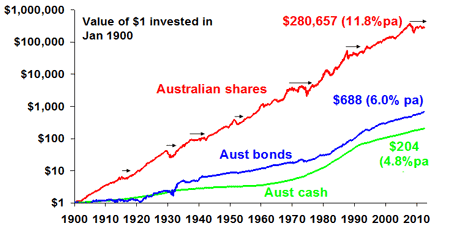What Is An Asset Class?

An asset class is a category of security or investment expected to perform in similar ways over time. Different asset classes typically have different expected levels of risk and return. Generally speaking, higher risk asset classes can offer higher prospects of long-term growth, while lower-risk asset classes can offer lower prospects of long-term growth.
Spreading investments across different asset classes may allow investors to diversify their portfolios instead of putting all their investment “eggs” in one basket. Smart investment diversification is seen by some as a way of reducing overall investment risk and increasing the likelihood of an optimal return. During the market volatility triggered by the global pandemic, asset class diversification helped many investors reduce the level of risk in their portfolio and also reduce prospective losses when global share markets retreated in early 2020 (by having exposure to asset classes that did not fall as precipitously as global shares during this period). Find out more about three different methods of investment diversification.
While the definition of an asset class is straightforward, there is considerably more discussion over just how many asset classes there are. Investopedia defines three primary asset classes – shares, bonds and cash – as well as property and commodities, while others include infrastructure and foreign currencies.
Economists are now debating whether Bitcoin represents a new asset class or whether it should be considered as a subset of the currency class. You can learn more about which assets can offer the strongest returns.
Shares versus bonds & cash over very long-term – Australia

Shares (also known as equities or stocks)
When you invest in shares, you’re quite literally buying a share in the ownership of a company. Shares are traded on a stock exchange after being issued by a publicly held company. Shares can make you money through capital growth – when the share price increases – or through dividends.
Historically, shares have been shown to outperform other investments over long periods of time but can be more volatile in the short term. There’s never a guarantee of return and it’s possible the share price will fall below the price at which you bought.
Related Article: 5 Australian Investment Apps You Should Know About.
Bonds (also known as fixed-income securities)
Bonds can be issued by governments and companies as an alternative to borrowing from banks. They act as a kind of IOU, with the issuer promising a regular stream of income over a set period of time before returning investors’ capital in full.
Once they’ve been issued, bonds can be bought and sold between investors without the issuer’s involvement. Bonds typically offer greater stability and lower returns than shares.
Related Article: Term Deposits Vs Online Savings Accounts.
Cash
For centuries, cash in the bank has been the financial staple for societies around the world – so much so that most people don’t really view it as an investment. Cash investments such as savings accounts and term deposits typically offer low returns in the form of interest, but can offer the greatest level of security and can be government-backed to increase consumer trust.
Infrastructure
Infrastructure as an investment class allows people to invest in income-producing assets such as toll roads, airports, public transport, and energy generation and distribution. Infrastructure is typically viewed as a more defensive asset with lower volatility than shares, particularly as it usually involves essential services.
Infrastructure investment growth typically comes from income/dividends (rather than price appreciation), but it can move between defensive and growth depending on market conditions and the assets involved.
Property
Outside of buying your own home or investment property, it’s possible to invest in commercial and listed real estate in Australia and internationally. Values tend to rise and fall more slowly than shares and bond prices but can fluctuate more swiftly depending on the market and location. Property is primarily a long-term, growth asset.
Foreign currencies
Foreign currencies are tradeable 24 hours a day and are highly speculative and volatile. Currencies can rise and fall daily and can be affected by market movements, political and economic factors among other things.
Commodities
Investing in commodities involves buying physical assets such as gold, copper, oil and wheat. The price dynamics of commodities are heavily affected by supply and demand.
Growth and defensive assets
Each of these classes falls somewhere between two broad categories – growth and defensive assets.
Growth assets, such as shares, are designed to grow your investment and tend to expose investors to higher levels of risk while also delivering a greater potential for returns over a longer investment time frame. Returns can come through income on dividends but typically returns are provided through capital (price) growth. Growth assets can experience greater volatility in value, especially over shorter periods of time.
Defensive assets include investments such as cash and bonds that tend to generate lower long-term returns but can cushion investors against volatility. Defensive assets typically provide returns in the form of income.
|
Type of investment |
Risk profile |
Typical characteristics |
|---|---|---|
| Shares | Growth | Divided into domestic and international, shares are typically considered high-risk, high-reward. |
| Bonds | Defensive | Returns are typically higher than cash but lower than shares or property. |
| Cash | Defensive | Returns come from interest and tend to be lowest of any asset class. |
| Property | Growth/defensive | Can be listed or unlisted, domestic or international. Property can’t always be easily categorised as growth or defensive due to its broad nature. |
| Infrastructure | Typically defensive | Can help balance portfolio volatility. Returns are typically higher than bonds but lower than shares. |
| Commodities | Typically growth | Physical goods whose values can fluctuate greatly based on supply and demand. |
How can asset classes help diversification?
Investing in a variety of asset classes is a way of spreading your investment risk and cushioning the overall value of your investments. If your portfolio is invested in a small number of assets, an unexpected change in conditions affecting those assets can potentially have a drastic impact on your returns.
However, if your investment “eggs” are spread across a wide variety of asset “baskets”, each with different characteristics and profiles, the overall risk of your portfolio being impacted by inevitable change might be reduced. This is because the negative performance of some investments tends to be offset by the positive performance of others.
Over the longer term, the entire portfolio will be expected to yield higher and less volatile average returns.
How to invest in different asset classes
Technology is making it simpler to invest in a variety of asset classes that have been historically difficult to access. Investors can now construct a diversified portfolio using many or all of the outlined asset classes using exchange-traded funds (ETFs), which trade on the Australian Stock Exchange. The ASX estimates the value of the Australian ETF market over $100 billion in May 2021, with more than 220 ETFs currently listed on the ASX.
It’s possible to invest directly in ETFs online or use the services of either a broker or an automated investment company (or robo-advisor). Read more about ETFs and what to look for when choosing them.
This article was reviewed by our Content Producer Marissa Hayden and Content Producer Isabella Shoard before it was updated, as part of our fact-checking process.

- Shares versus bonds & cash over very long-term – Australia
- Shares (also known as equities or stocks)
- Bonds (also known as fixed-income securities)
- Cash
- Infrastructure
- Property
- Foreign currencies
- Commodities
- Growth and defensive assets
- How can asset classes help diversification?
- How to invest in different asset classes
Try our Investor Hub comparison tool to instantly compare Canstar expert rated options.





